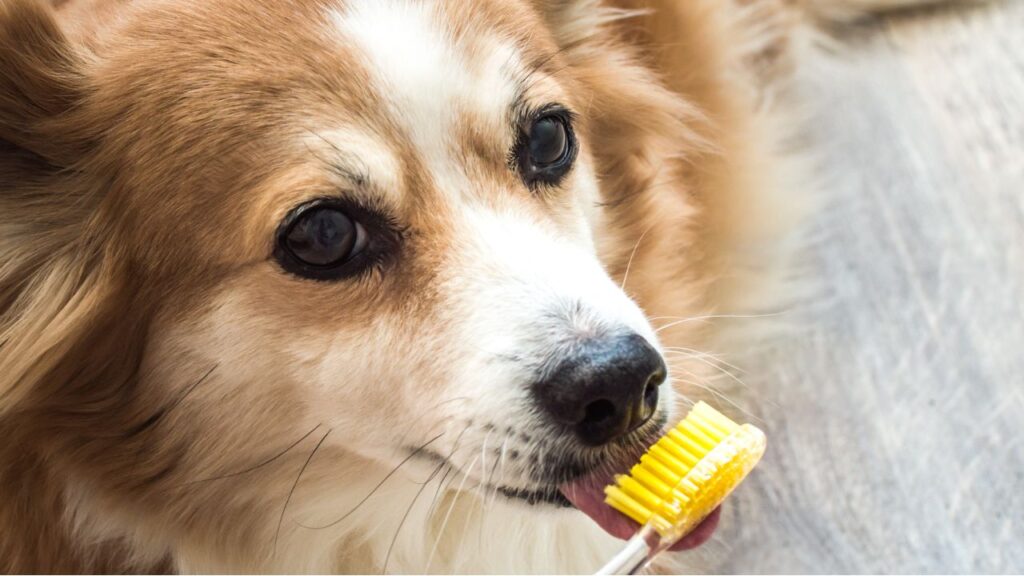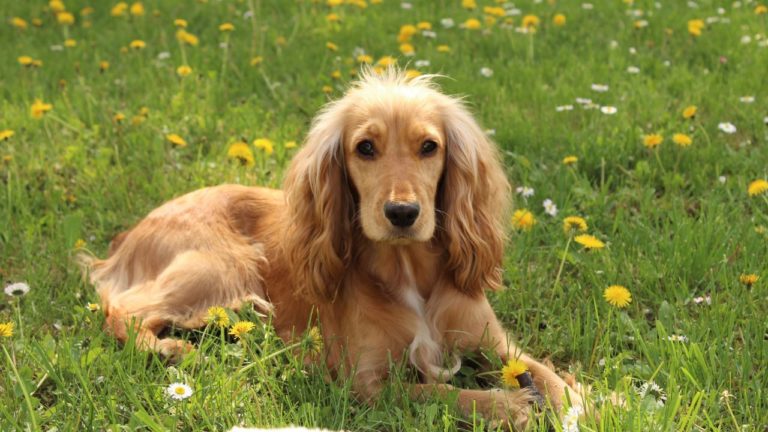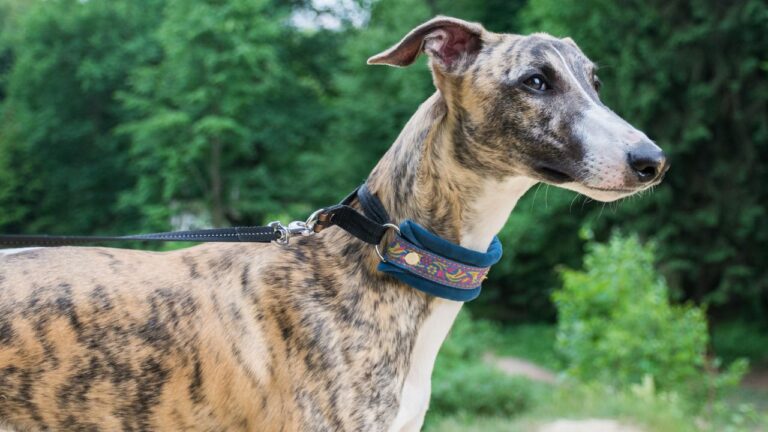Brushing Dogs Teeth: It’s Easier Than You Think!
Toothbrushing for dogs? Yup. Brushing dogs teeth is surprisingly easy, and has long-term benefits. Not only will it keep your dog's breath fresh, it will keep his internal organs healthy, and may even lower the risk of mouth cancer, the fourth most common cancer in dogs. Totally worth it!

Read Time: 6 minutes
We know what you’re thinking. Brushing dogs teeth? Really?
Really.
Brushing your dog’s teeth is an important part of routine care that can not only help to keep down dental care costs in the future, but also prevent a variety of serious health problems like heart disease and oral cancer.
Why Should We Be Brushing Dogs Teeth?
Many people think that dogs don’t need their teeth brushed. But there are many benefits to brushing your dog’s teeth.
Brushing Dogs Teeth Leads to Better Breath
Like us, dogs build up plaque and calculus (the fancy word for tartar) on their teeth. Plaque is a nasty mix of saliva, food particles, and bacteria.
Plaque is easy to remove, but if you leave it alone, it will eventually build up into calculus. Calculus is the hard, grey-brown layer that you have probably seen on older dogs’ teeth, and it does NOT like to come off.
All that bacteria happily living in your dog’s mouth causes odor, and the more plaque and calculus there is, the worse the odor will be.
Brushing your dog’s teeth can’t remove calculus, but it can remove plaque. So the best thing to do is brush your dog’s teeth frequently to remove plaque BEFORE it becomes calculus.
It Also Prevents Periodontal Disease
Plaque and calculus don’t just cause bad breath. The steady buildup of bacteria and debris irritates the gums, causing inflammation and swelling. You probably know this as gingivitis. Gingivitis hurts.
Irritated gums are more prone to infections, which makes the situation even worse.
Over time, the tissues around and supporting the teeth decay and are broken down, leaving the roots of the teeth exposed to the invading bacteria. From there infection can even get into the sensitive pulp in the center of the teeth, which is quite painful.
Infection can also spread into the jawbones, eventually leading to bone loss and possibly fractures.
Signs of periodontal disease include:
- Bad breath
- Red angry gums
- Gum recession (teeth look longer)
- Calculus buildup
- Loose teeth
- Oozing sores in the mouth
- Teeth falling out
- Reluctance to eat, especially hard foods
The damage from periodontal disease is often permanent. Loose and damaged teeth must be removed, and your dog will require antibiotics to resolve the infection.
It Also Prevents Systemic Diseases, Including Cancer
As if all that wasn’t bad enough, bacteria that builds up on the teeth don’t just stay in the mouth.
They can hitch a ride in the bloodstream and spread throughout your dog’s body.
This can lead to infections throughout your dog’s body and in her internal organs. Dogs with bad teeth are at an increased risk of heart disease, kidney failure, tooth abscesses, eye problems, and oral cancer.
Good dental health can extend your dog’s life by two to five years.
Convinced that you should brush your dog’s teeth? Great. Let’s cover how to build a lifetime of good habits, no matter how young or old your dog is now.
How to Brush Your Dog’s Teeth for the First Time
Toothbrushing for dogs is a marathon, not a sprint. You’re going to be doing this pretty much every day for the rest of your dog’s life, so you don’t want to have to wrestle her.
You may need to be patient with your dog and yourself, though. Some dogs will let you proceed quickly through the phases of training, but others will need more time.
Expect to spend a couple weeks on each phase, but it may take months to work up to brushing your dog’s full mouth in one sitting.
Things you Will Need for Brushing Dogs Teeth
- A Toothbrush: toothbrushes for dogs have an angled head that is a little easier to use, but any soft toothbrush will do. This is a good brand I like to use. It has two heads, large and small, so you can get into the small spaces.
- A Dog-friendly toothpaste: ingredients are non-toxic to dogs, and often come in nice meaty flavors. Pet toothpaste also usually contains enzymes that target plaque, so just having the toothpaste in your dog’s mouth will help a little with dental care even before you get to really brushing. I make a specific recommendation below.
- A time of day: try to brush your dog’s teeth at the same time each day. It is easiest to remember if you pair it with something else that you do during your daily routine, such as brushing your own teeth.
Phase 1: Teach Your Dog Toothpaste is Tasty
Offer a little dog-friendly toothpaste on the brush for your dog to lick each day. This introduces the brush and teaches your dog that a toothbrush = a tasty treat.
Repeat this at “toothbrush time” every day until your dog starts to look forward to it.
Phase 2: Touching Your Dog’s Teeth and Gums
Lift your dog’s lip and smear the toothpaste in part of her mouth, then let her lick the rest off the toothbrush.
The swipe should be a very brief, gentle motion. Your dog will likely think you’re weird, but by being quick her annoyance won’t last long. And then she gets the reward of the remaining toothpaste on the brush.
Repeat daily until she is relaxed about the brief touch of the brush on her teeth/gums. You can rotate which area of the mouth you target.
Phase 3: Let’s Get Brushing to Your Dog’s Teeth
Time to do a little actual brushing! When you lift your dog’s lip, move the brush in a gentle circular motion. Keep it short – just a couple seconds. Then let her lick the rest of the toothpaste off the brush.
Tailor the length of time that you brush to your dog – if she is uncertain, keep it short for a while, but if she is relaxed, you can increase a little each day.
Gradually build up to brushing your dog’s entire mouth. Depending on your dog’s personality and comfort with having her mouth handled, it may take a couple months before you can brush her full mouth.
Keeping Teeth Brushing Positive
- Progress slowly
- Be patient
- Use an enzymatic toothpaste
- Try different toothpaste flavors if your dog dislikes one
- For puppies under 6 months old who don’t have all their adult teeth, just let them lick toothpaste off the brush
- Don’t brush for a week or so after dental cleanings/procedures (but you can offer a little toothpaste)
How Often Should I Brush My Dog’s Teeth?
Every day! Brushing dogs teeth daily, along with regular dental cleanings at the veterinarian, is the gold standard for dental care in dogs.
If you do miss a day or two once in a while, don’t beat yourself up. Brushing your dog’s teeth when you do yours is an easy way to help remember (we don’t recommend sharing toothpaste though!).
Brushing daily along with regular dental cleanings is the gold standard for dental care in dogs.
Note: some dogs build up plaque more rapidly than others. Daily tooth brushing will help your dog’s dental health significantly, but she will still need a couple professional cleanings with your veterinarian over the course of her life.
Tip: Use a Toothbrush Made for Brushing Dogs Teeth
The best tool for the job is a toothbrush designed to be used on pets. These brushes have an angled head that makes them a little easier to maneuver around your dog’s teeth.
Don’t have a dog toothbrush? No worries – your pooch can use any spare soft-bristle brush you have on hand.
For small-breed dogs, the standard dog toothbrush head may be too big. Many pet toothbrushes come with a head on each end, one large and one tiny. The tiny end is perfect for a cat or tiny dog!
Finger brushes are another alternative. These are thin rubber “thimbles” that fit over your finger and have a textured section for brushing. They are very gentle on your dog’s gums, and easy to maneuver. The downside is that the short rubber bristles may not remove plaque as well as the bristles on a brush. Also be very careful about where your finger is in your dog’s mouth – he could easily bite through the rubber by accident.
Another option that can be useful for small dogs in particular is to wrap some plain gauze around your finger and use that as a brush. Again, it won’t get into all of the little nooks and crannies of the teeth like brush bristles can, but it’s an easy-to-use option that you can pick up anywhere.
Can’t I Use a Supplement or Water Additive?
You can, but none of these products are as effective as the mechanical action of brushing the teeth.
Individual dogs will also have different needs for plaque prevention. One of my dogs had very little calculus on her teeth at 9 years of age, while her daughter had a garbage mouth at 2. Both were getting the same dental health supplement in their food. I started toothbrushing for all of my pets (even the cat!), and haven’t needed anything else.
If your dog is especially prone to plaque and tartar buildup (we’re looking at you, Chihuahuas, and Dachshunds), use multiple dental care strategies along with daily brushing to hit the bacteria on multiple fronts.
The Best Toothpaste for Dogs
Most pet toothpastes include enzymes that help to break down plaque (the mechanical action of the toothbrush then swishes it away).
Do not give human toothpaste to your dog. Human toothpaste is not intended for internal consumption. It’s intended to be spit out. Dogs won’t spit it out, and it can be unsafe for dogs to consume.
Dog-safe toothpaste is readily available from your local pet supply stores, vet’s office, and online. If your dog is picky, try different flavors to see what she likes.
My dogs have tried Sentry Petrodex, Vetoquinol, C.E.T., PetSmile, and Arm & Hammer toothpaste brands and gave all of them two paws up (my cat prefers chicken flavor and did not care for London broil).
A great place to find dental health products is the Veterinary Oral Health Council, which lists products tested to ensure they work (note: third-party testing is not required).
Happy brushing!
Paws and wags,
Kate
Further Reading and References:
https://phys.org/news/2021-02-gold-standard-pet-dental-health.html
Veterinary Oral Health Council
Kate Basedow, LVT
Topics
Did You Find This Helpful? Share It with Your Pack!
Use the buttons to share what you learned on social media, download a PDF, print this out, or email it to your veterinarian.
Editor's Picks
CATEGORY





